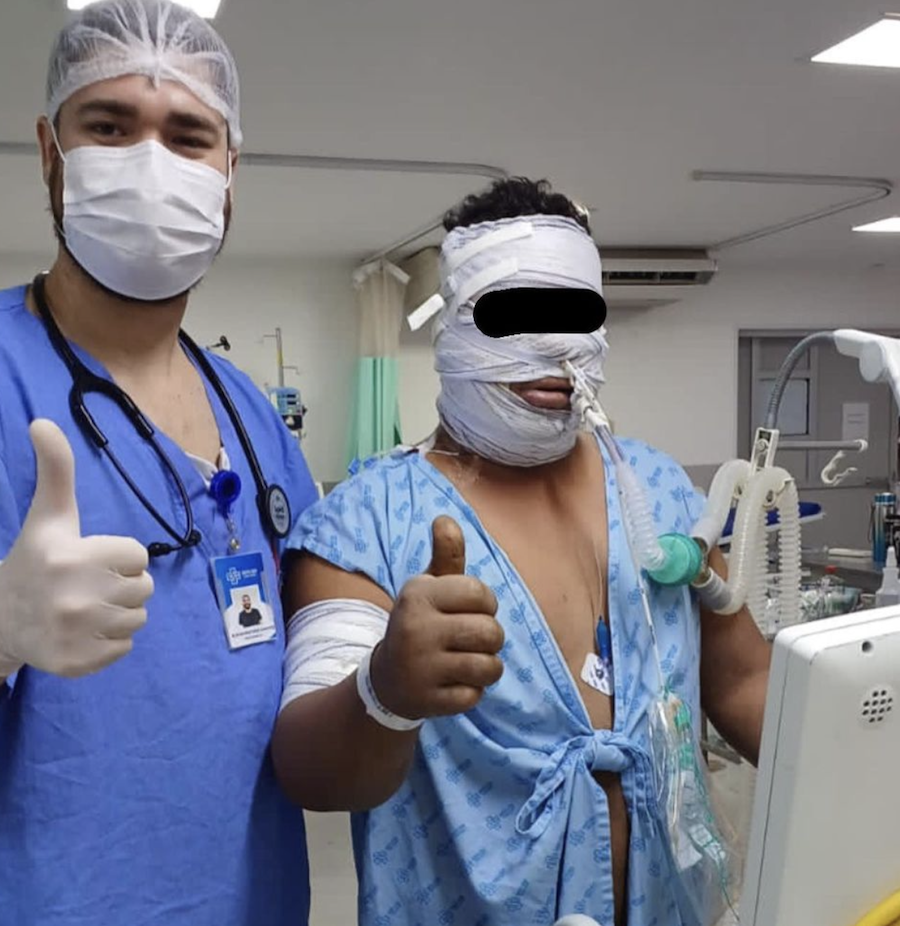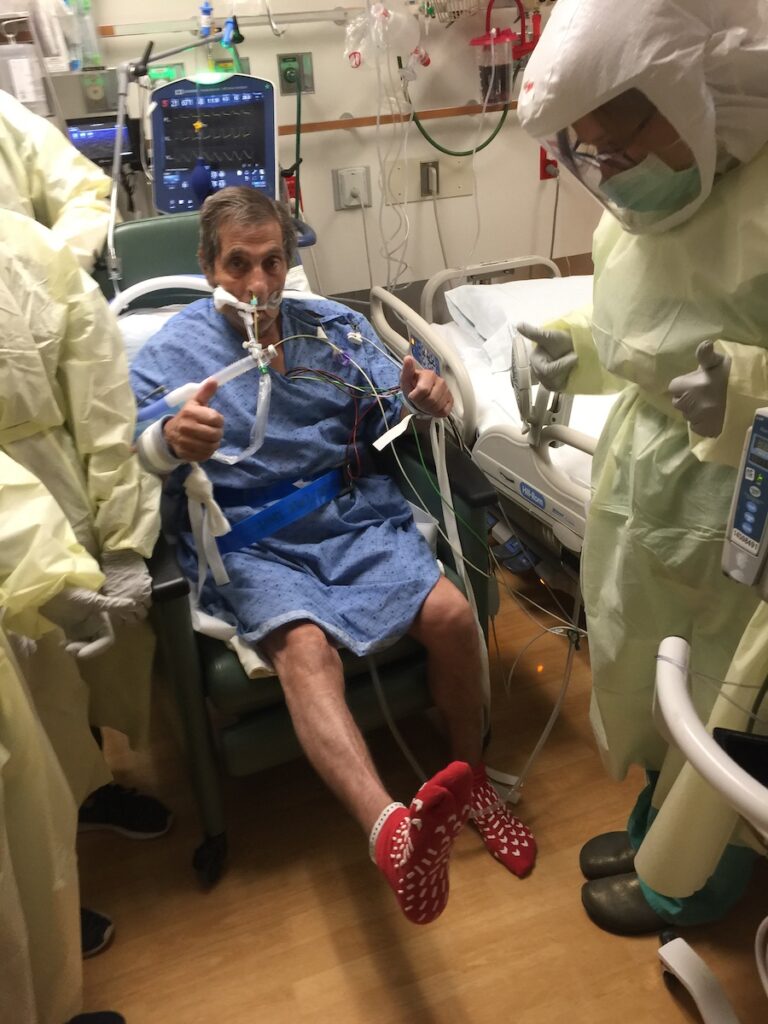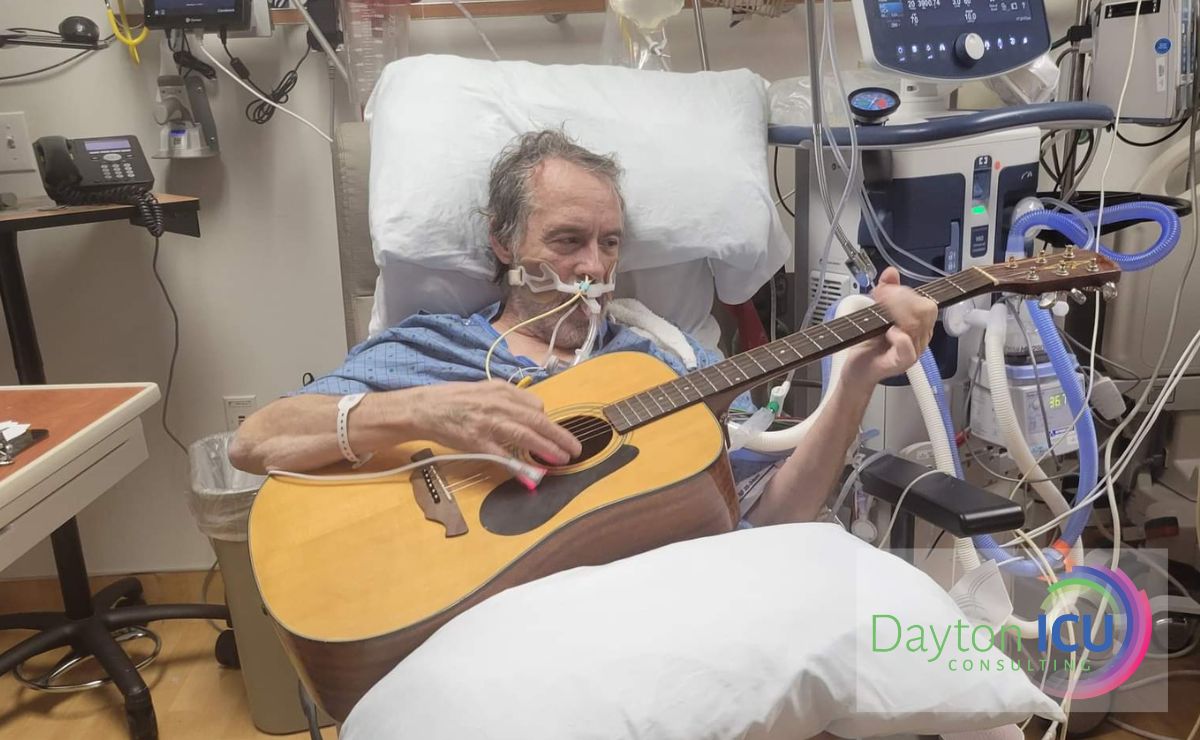The Awake and Walking ICU approach is deeply rooted in science, pathophysiology, and logic.
Yet some of the best fruits of this method are humanity, compassion, dignity, and love.
We use this approach to humanize the ICU, and I believe that is a desire of most ICU clinicians.
But the reality is, no matter how much we want to treat our patients as the valued individuals they are, humanizing the ICU requires humans. Human hands. Human minds. Human time. Human touch.
A common response I get when sharing information on this subject is, “We do not have the staff to do this.”
On one level, I understand where these clinicians are coming from, as the implementation of these protocols is heavily dependent on having an adequate staffing level, and we’re currently in the middle of a staffing crisis.
But sadly, these kinds of statements reveal a deep misunderstanding of these processes.
The truth is the implementation of the ABCDEF Bundle should be seen as an investment rather than an expense.
These protocols provide a long list of benefits for patients, clinicians, and the hospitals where they practice, including better patient outcomes, improved working conditions, and cost savings that go far beyond what it would cost to hire enough staff to implement and sustain the ABCDEF Bundle.
I’ve been ecstatic to see that the adoption of these practices is becoming increasingly common, especially as more and more clinicians and hospital executives become aware of not just the clinical advantages of these protocols, but also The Financial Benefits of the ABCDEF Bundle.
But even though an increasing number of ICUs are trying to implement these practices, many are attempting to do so without adequate staff, as they’re failing to understand that adequate staffing is all part of the investment they’ll have to make in order to get the return.
This article offers insights into the benefits of this method and explores what the research says about ICU staffing ratios and the Awake and Walking ICU approach.
ICU Staffing Ratios and the Awake and Walking ICU Approach

Creating an Awake and Walking ICU requires full implementation of the ABCDEF bundle, and if you want to ensure it gets successfully implemented, you’ve got to have an adequately staffed ICU.
Having a shortage of clinicians can severely hinder your ability to provide the necessary attention, monitoring, and support that’s required to apply these practices.
That being said, if you want to fully realize the benefits of this method, it’s essential to address staffing challenges.
To give you a better idea of what I’m talking about, let’s explore several reasons why the Awake and Walking ICU approach cannot be properly applied without adequate staffing.
Continuous Monitoring and Assessment
The ABCDEF Bundle emphasizes regular assessment of the needs of patients, such as sedation level, delirium monitoring, and when patients are ready to be weaned off of sedation.
These assessments require the constant attention of clinicians, and inadequate staffing can lead to delays in assessments or incomplete evaluations, potentially causing complications to go unnoticed.
Early Mobilization and Rehabilitation
Early mobility and exercise are integral components of this process, but patients need assistance and supervision in order to engage in physical therapy and mobilization.
A lack of sufficient staff means patients may not receive the appropriate support for safe and effective rehabilitation, which can increase the risk of complications and erode the ability to properly implement these protocols.
Sedation Management
Proper sedation management is a key element of the ABCDEF Bundle. Nurses must be able to help decide whether or not sedation is needed, titrate sedation to the appropriate levels, and then be physically present to help patients safely emerge from sedation.
But when nurses have more than two patients, they are less able to assess and adjust their approach with each patient. They are unable to take the time needed to assess and treat pain and delirium, speak with patients, help them communicate with staff, educate family, and provide the care needed to help patients acclimate to the endotracheal tube and stay calm.
Nurses are left without support and unable to be at the bedside, and so sedation is often continued and sometimes increased.
When sedation management does not align with the ABCDEF Bundle, patients are oversedated, do not pass breathing trials, and remain on the ventilator for longer. This increases the risks and severity of delirium, which can double the nursing hours required for care, increase time in the ICU by 4.77 days, and increase costs by 39%.
At the end of the day, this kind of understaffing impacts sedation practices, which results in more ventilators, more occupied beds, more demand for clinicians, more work for ICU teams, more harm for patients, and more expenses for hospitals.
Ventilator Weaning and Extubation
Timely weaning from mechanical ventilation is essential to reduce complications associated with prolonged ventilation.
This process requires constant monitoring and timely adjustments. When patients had a need for sedation but now need to be weaned off, they are at high risk of emerging from sedation with delirium.
When this happens, patients can be confused, terrified, agitated, and difficult to keep safe from violence, line/tube removal, or falls.
The reality is, when an ICU is understaffed and a nurse is left alone with more than two patients and no team support, they are unable to provide the care needed, including things like communication, pain management, and early mobility.
This moment of panic and danger usually results in the resumption of sedation, and although the patient could likely be extubated that day, their delirium and resumed sedation will lead to more time on the ventilator.
This cycle often continues each day until patients are too weak to “fight” during their awakening trials, and this leaves patients vulnerable to higher risks of ventilator associated pneumonia, pressure injuries, delirium, central line and urinary tract infections, and ICU-acquired weakness.
These additional days or even weeks on the ventilator and in the ICU also increase the demand and workload for clinicians, while driving up expenses for hospitals.
But if you have the staff needed to help patients stay safe, calm, mobilize, communicate, and recover from delirium during awakening trials, it can help transform patient outcomes and drastically decrease staff workload and hospital costs.
Delirium Management
Management of delirium in the ICU requires careful monitoring, but when patients are deeply sedated it is impossible to assess them for delirium.
When sedation is turned off and patients have delirium, they may need someone to sit at the bedside and continually re-orient them and monitor them to keep their lines and tubes safe. When nurses are understaffed, they are unable to provide this level of care.
Even patients that are not intubated can end up being sedated in response to delirium, as busy clinicians feel patients are safer when they are unable to move while they are in another room with another patient.
Patient care technicians can provide incredible return on investment when they help patients stay safe and free from sedation by providing human touch and attention.
At the same time, the increased time in the hospital, risk of readmission, and legal liabilities from improper delirium management can be a significant risk for hospital finances.
With that in mind, adequate staffing can help to protect patients, clinicians, and hospitals.
Family Engagement
The Awake and Walking ICU approach focuses heavily on family engagement and empowerment, as families play a vital role in the patient’s care and decision-making.
But without sufficient staff, the time and attention required to effectively communicate with and support families may be limited, potentially leading to misunderstandings, anxiety, dissatisfaction, and an erosion of trust in clinicians and the healthcare system in general.
Quality of Care and Burnout
In an understaffed ICU, clinicians are more likely to experience burnout, which can have a significant impact on the quality of care they’re able to provide.
Overworked staff may struggle to consistently adhere to the protocols outlined in the ABCDEF Bundle, which can jeopardize patient safety and outcomes.
Failing to practice the ABCDEF Bundle deprives hard-working clinicians of the satisfaction and fulfillment of seeing their patients succeed and walk out the ICU doors as a result of their labors.
And having to witness consistently poor patient outcomes, despite their diligent efforts, can drastically exacerbate burnout for clinicians.
Patient Safety
Inadequate staffing levels can compromise patient safety in various ways, such as an increased risk of medication errors, falls during mobilization, and inadequate infection control measures.
All of these factors can have a significant impact on the well-being of critically ill patients, while exposing clinicians and hospitals to potentially devastating legal liabilities.
My Take on ICU Staffing Ratios

When I worked as a nurse in an Awake and Walking ICU, two patients to one nurse was standard.
In that 16-bed ICU, we had a certified nursing assistant (CNA) on the unit, and physical and occupational therapists prioritized the ICU, but also worked on the medical floors.
Physical therapists worked with us to do two mobility sessions with our patients during the day and I utilized respiratory therapists (RTs), CNAs, and family to mobilize my patients on night shifts.
To many, these may seem like “normal” staffing ratios. To others, this may seem like a far-off dream, as some ICUs in this country are regularly giving ICU nurses three patients and charge nurses are taking their own patient loads.
At any rate, ICU staffing ratios should never exceed one nurse for two patients. It is well-known that higher ratios impair the ability to do adequate monitoring or properly administer medications, for instance.
And if nurses are trying to handle more than that, it is impossible to create an Awake and Walking ICU.
What is often left out of the discussion on ICU staffing ratios is the effect they can have on sedation and mobility practices, and therefore patient outcomes and healthcare costs.
The Awake and Walking ICU approach to sedation and mobility requires patients to remain awake, calm, communicative, and mobile. This is impossible without enough expert nurses, attentive CNAs, available RTs, accessible physical and occupational therapists, and involved providers at the bedside.
This approach requires human hands to hold patients’ hands, move their lines, gather equipment, push the ventilator, and help patients walk, and when patients are confused or agitated, it requires time and attention to address their needs, instead of just sedating them.
The entire team needs to have the bandwidth to see beyond the tasks, procedures, and medications and focus on the bigger picture for each patient, and all of this requires adequate staffing ratios.
Many have assumed that an Awake and Walking ICU requires a 1:1 ratio. Undoubtedly, such ratios would provide the most optimal care and outcomes for patients, and would help to mitigate burnout while improving the work environment, and staff retention, which by itself would likely lessen healthcare costs.
Nonetheless, in the current situation, such ratios are not attainable. However, we cannot afford to continue using standard sedation and mobility practices, especially during the current staffing crisis.
Why You Can’t Afford to Not Practice the ABCDEF Bundle
As I’ve already mentioned, the ABCDEF Bundle offers significant benefits for both patients and clinicians, along with the hospitals where they practice.
There is vast evidence to support this, but many stakeholders still aren’t aware of this.
If you’re still on the fence about hiring the staff that’s required to implement this approach, it’s important that you understand its advantages, particularly when it comes to the financial benefits, as well as the consequences of not practicing it.
For one thing, increasing the number of patients to each clinician is known to increase the risks and harm to patients, all of which drive up costs.
An observational study showed that when nurses have more than 2.5 patients, their risk of death increases by 3.5 times.
In another study, increasing the ratios by one RN per patient decreased the risk of hospital-acquired pneumonia by seven times, unplanned extubations by nearly five times, respiratory failure by four times, cardiac arrest by over seven times, and the length of stay decreased by 24%.
We also know, based on at least one review of nursing and medical literature, that the greater the nursing workload, the more falls, central-line associated blood infections, staff turnover, and staff no-shows occur.
As was shown in another systematic review, this is all part of the reason why better ICU staffing ratios actually decrease patient care costs.
At the same time, as this systematic review and meta-analysis shows, we know that sedation drastically increases time on the ventilator and time spent in the ICU.
Even in a study comparing interrupted sedation to no sedation, the no-sedation group spent over four days less on the ventilator.
We see in one study, which came to the same conclusions as many others, that early mobility (even at a lower dose than in an Awake and Walking ICU) decreases ICU length of stay by 20% and increases discharges home without services by 22.3%.
Moreover, we know that delirium doubles the nursing hours required for care, increases workplace violence, increases line and tube removals, increases falls, and ultimately increases time in the ICU and hospital by 4.77 and 6.67 days, respectively.
We also know that the ABCDEF Bundle, even when used at suboptimal doses, decreases delirium by 25-50%, and sedation alone increases the risk of delirium by 8.5 times.
What’s more, ICU-acquired weakness can prolong time on the ventilator by 20 days in sepsis patients.
One study found that an ICU team that increased its CVICU-dedicated physical and occupational therapists from two to four clinicians experienced a 3.6-day decrease in ICU length of stay!
Furthermore, ICU-acquired weakness and delirium are extremely laborious and taxing for our ICU teams.
Delirious patients are much more difficult and dangerous to deal with, and creating weak and dependent patients increases the demand for turning them every two hours, pressure injury care, more staff needed for mobility, more wait times for care facility discharges, and more time on the ventilator.
That being said, delirium increases healthcare costs by 39% and ICU-acquired weakness increases costs by 30.5%.
Fortunately, the Awake and Walking ICU approach protects patients and staff from delirium and ICU-acquired weakness.
This approach also minimizes complications, which decreases the time patients spend in the ICU and the demands that are placed on ICU teams.
And by allowing most patients to be awake shortly after intubation, the ABCDEF Bundle makes it more likely that patients will be oriented, calm, communicative, and therefore cognitively and physically able to participate in their care.
They are usually able to help mobilize themselves and this can also help decrease the staff and time required for each mobility session.
In addition, they’re also more likely to be able to successfully extubate and walk out of the hospital doors themselves, minimizing the care required for mechanical ventilation.
As a result, ICU bed flow becomes less dependent on bed openings in care facilities, and ICU staff are less burdened by the stress of delirium, ICU-acquired weakness, and having to do an incredible amount of work for poor outcomes.
At the same time, clinicians in an Awake and Walking ICU learn to utilize and optimize each other’s expertise for an efficient process of care that then minimizes the care patients require.
And all of this leads to at least a 30% decrease in healthcare costs.
All things considered, we cannot afford to continue practices that increase time in the ICU, nursing demands, risk to staff, burnout, and poor staff retention.
The Awake and Walking ICU approach guides teams to work smarter, not harder, and it represents one of the biggest possible returns on investment in the hospital system.
So, during this financial and staffing crisis, instead of asking, “Can we afford to hire the staff that’s required to implement these practices?” maybe it’s time to look at the bigger picture and ask, “Can we afford to not practice the ABCDEF Bundle?”
Do you want to turn your ICU into an Awake and Walking ICU? We can guide you through the entire transformation, and we look forward to discussing your team’s needs. Please contact us here.




